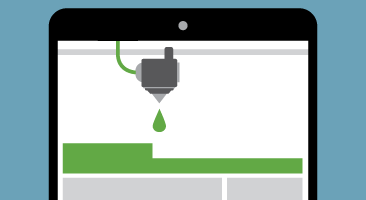Save 50% on a 3-month Digiday+ membership. Ends Dec 5.

This article was written by Matt Gillis, President, Platform Business, Millennial Media
Earlier this year at the Game Developers Conference in San Francisco, I saw a giant 3D printer in action. It’s still very surreal to watch a machine churn out three-dimensional models of a gaming company’s characters as casually as my office printer cranks out spreadsheets.
The models looked and felt like toys, but they’re also an integral part of the animation process. These objects actually begin in two dimensions, and only gain depth, width and height through 3D printing; they’re then translated back to a two-dimensional state. Rendering cartoon models is just one of 3D print’s many uses. Biotechnologists can “print” bone and flesh, and industrial manufacturers are crafting durable goods like body armor for soldiers and prosthetic limbs for amputees.
“Print” doesn’t even sound like the right verb to use anymore. At times, 3D printing seems like a magician’s black hat, bottomless and capable of producing anything: flowers, rabbits, musical instruments, home furnishings, human body parts… Anything you can imagine.
But that’s the key — first, someone has to imagine it.
There is no ghost in the machine
However complex and efficient they become, 3D printers don’t have minds of their own. They’re just boxes that turn slabs of plastic into objects. Without a programmer, they sit idle, waiting to be called into service.
Ad position: web_incontent_pos1
There’s actually a parallel in ad tech. Today, thanks to the incredibly powerful and creative coding that enables us to deliver programmatic advertising, machines are an ever more essential part of the media landscape. Programmatic technology allows us to be more relevant and specific than ever, while data-mining makes it easier to connect with the right person at the right time.
But before we can place any ad in front of its ideal audience, we need human judgment and imagination to manage the program and craft the right message.
Get to know your friendly neighborhood media buyer
In 2013, the average consumer had his mobile phone with him 22 hours out of the day, according to the IDC, and 80 percent of U.S. consumers check their smartphones within 15 minutes of waking up. Research from eMarketer shows that consumers spend nearly three hours a day on their mobile devices, creating mounds of data and a wealth of opportunities for brands to engage with their desired audience.
Data is an essential element of any programmatic campaign. Location and contextual data can be layered atop prior interactions, and a specific ad can be served. Teams of analysts, planners and media buyers review visualizations, make recommendations on which data to use, determine which partners to work with, then finally set up campaigns to execute the buy.
Ad position: web_incontent_pos2
Though acronyms like RTB, DSP, and DMP are tossed around casually by programmatic veterans, they sound like a foreign language to the uninitiated. The role of a media buyer has an even greater strategic importance for brands taking the plunge into programmatic buying.
Trusted partners matter more than ever
When it comes to executing a campaign, buyers are faced with an increasing number of choices. Based on their campaign goals, buyers may want to purchase impressions in an open exchange or private marketplace, or take advantage of programmatic “pipes” to realize the efficiencies of automation while working with a specific publisher in a “programmatic direct” buy.
Complex algorithms bid on impressions based on their perceived value and optimize campaign performance across multiple dimensions, capitalizing on nuances undetectable by the human eye. Harnessing the power of technology enables those executing the campaigns to focus more time evaluating performance metrics, testing messaging concepts to see what resonates with their target audience, and ultimately developing a deeper understanding of the their customers.
The transparent nature of exchange-based buying offers a myriad of data points on which to evaluate campaign, app or site, device, location, and ad performance, among other dimensions. But it’s up to the analysts, buyers and planners to make sense of this data and determine the appropriate course of action.
Technology still needs a human touch
The strategic nature of programmatic buying enables media buyers and sellers to develop and strengthen their partnership as both organizations strive for an outstanding consumer experience. Relying on the expertise of a valued partner is a great way for brands to get started in programmatic buying.
Just like 3D printers, programmatic is enhanced by both the human touch and automated technology. Both are quickly changing the way we interact with the world and the way we approach future innovations. I can’t wait to see what is next, and how it shapes the way we live and work.
More from Digiday

What publishers are wishing for this holiday season: End AI scraping and determine AI-powered audience value
Publishers want a fair, structured, regulated AI environment and they also want to define what the next decade of audience metrics looks like.

Ulta, Best Buy and Adidas dominate AI holiday shopping mentions
The brands that are seeing the biggest boost from this shift in consumer behavior are some of the biggest retailers.

Digiday+ Research Subscription Index 2025: Subscription strategies from Bloomberg, The New York Times, Vox and others
Digiday’s third annual Subscription Index examines and measures publishers’ subscription strategies to identify common approaches and key tactics among Bloomberg, The New York Times, Vox and others.
Ad position: web_bfu